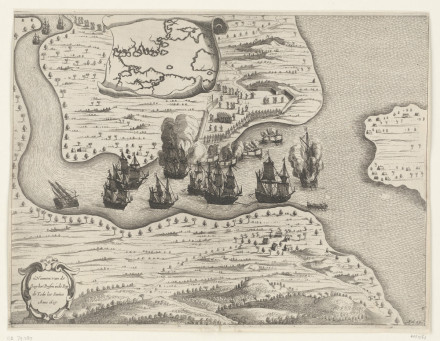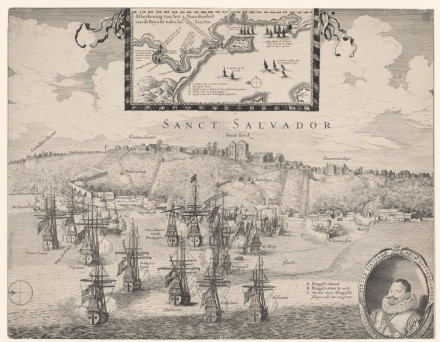History
Attack on San Salvador
The Amsterdam was the flagship of a WIC fleet of 12 ships, whose objective was to relieve and aid general Boudewijn Hendriksz. who had already been in the Caribbean with a fleet since 1625.
The new fleet left the Netherlands in May 1626 and was under the command of admiral Piet Hein. When they arrived in the Caribbean in late July, Boudewijn Hendriksz. had died and his fleet was already on the way back to the Netherlands. Piet Hein wanted to attack the silver fleet near Cuba in August 1626 but he considered his force to weak and decided to go to Brazil and attack the city of San Salvador instead. To get there, however, they needed to take a huge detour due to adverse winds: past the Azores and Sierra Leone.
On 3 March 1627 they arrived at San Salvador and attacked the city. With his nine ships Hein attacked the fleet of 26 ships there in the Bay of All Saints and managed to capture them all. The Amsterdam however ran aground at night and was shot to pieces by artillery from the city. It was then set on fire by the crew to avoid it being used by the enemy. Piet Hein got wounded in this battle by a musket shot to his left arm. Among the captured ships were also two slave ships. Hein took the ships but released the enslaved people on board.

Description
Yard: a yard in Amsterdam
Chamber: WIC chamber of Amsterdam
Tonnage: 600 tons/300 last.
Crew division: 240 sailors, 64 soldiers
Armament: 8 bronze cannons, 32 iron canons

| Master | Cornelis Dirksz. |
|---|---|
| People on board | 204 |
Status
The wreck of the Amsterdam was found in May 1979 by Robert Marx, a well known wreck diver. In 1980 a Brazilian salvage company, SALVANAV redt Ltda., got approval of the maritime department to collect objects. In January 1981 they returned with Robert Marx to the site of the Amsterdam wreck. The objects suggested the presence of a Dutch ship from the 17th century. All kinds of artefacts were found: iron cannons, weaponry, ceramics and personal items, as well as gold and silver. A part of this was auctioned at Christie's in 1983.

References
- De Laet III, 83, IV 103.